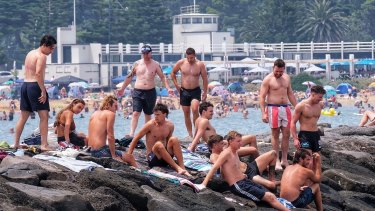Melbourne’s temperature cracked 30 degrees at 7.30am on Monday as Victorians brace for another day of intense heat.
Forecasters are predicting Melbourne will swelter through the hottest day of the summer, with a top of 39 degrees.
The high temperatures and gusty winds have combined to pose the “most significant” fire risk this summer.

Photo of people enjoying the hot weather at Williamstown beach on Sunday. Melbourne hit a top of 37. Credit:Luis Ascui
A total fire ban – where no fire can be lit in open air, including campfires – has been declared for the Mallee, Wimmera, Northern Country, North Central, North East and East Gippsland. Fire danger is considered to be “severe” across the northern parts of Victoria.
Melburnians sweltered through a sticky night with the temperature not falling below 24.8 degrees. By 7.30am on Monday, the temperature at Melbourne’s Olympic Park was 30.2 degrees.
At Melbourne Airport, the temperature didn’t drop below 28 degrees.
Bureau of Meteorology duty forecaster Christie Johnson said the mercury was expected to peak mid-afternoon, before a gusty cool change arrives at 5pm, bringing squally winds on the bay and evening rain.
“It’ll be fairly normal in Melbourne that the hottest part of the day will be mid-afternoon, around 3pm. The only thing that might affect it is with the front coming in, there will be increasing cloud,” she said.
“That cool change will move into the south-west of the state this morning, and move very slowly through western Victoria, arriving in the central districts late afternoon and in Victoria’s east tonight or in the early hours of Tuesday morning.
“For Melbourne, it is probably going to be the hottest day this season so far, but not necessarily the hottest day through the state’s north.”
Shepparton in Victoria’s north is expected to hit 43 degrees after 2pm on Monday, but residents will have to wait longer for some relief from the heat, with the cool change not expected until around 9pm.
Towns along the Victoria-NSW border like Echuca and Yarrawonga are forecast to reach 42 degrees in the mid-afternoon, and are expected to receive the cool breeze at 6pm, a little later than the capital city.
State Response Controller Chris Eagle said late on Sunday that the “next 24 hours is the most significant fire risk Victoria has seen this season”.
“Any bushfires still going when the gusty change comes through will make it challenging and dangerous
for firefighters on the ground,” he said.
Country Fire Authority Chief Officer Jason Heffernan said he was expecting significant gusts of 50 to 60 km/h, which will “really build those fire dangers” in some parts of Victoria.
Flames up to 10 metres high soared from a rubbish fire at a recycling facility in Brooklyn, in Melbourne’s west and about 10km from the CBD.
It took 40 firefighters about 40 minutes to get the blaze on Old Geelong Road under control after it started shortlt before 6am.
Emergency Management Victoria said smoke from the fire was billowing in a southerly direction, towards Altona North, and those who are sensitive to smoke should close windows and doors and turn off cooling systems.
Victoria has contracted 51 aircraft for this year’s bushfire season, including water-bombing aircraft, air supervision and air intelligence-gathering aircraft.
Despite the difficulties caused by the coronavirus pandemic, emergency services are well prepared for this year’s bushfire season, Emergency Management Commissioner Andrew Crisp said.
“It’s presented some challenges – we haven’t been able to get out and do the face-to-face briefings that we normally would have done,” he said.
“However, we’ve done that online. We’ve done that in such an effective way that it’s been a lot more flexible for volunteers to actually participate.”
As Victorians look to beat the heat on Monday, they’ve been warned to take care around beaches, rivers and pools, after two men died and countless others were dragged out of the water safety near the Great Ocean Road.
One man died after he was pulled from the water while swimming at Thirteenth Beach in Barwon Heads on Saturday, and another died after his boat capsized off Anglesea on the Great Ocean Road.
More than 42 Victorians have drowned since July last year, seven of them in the past 10 days.
Victoria’s brief heatwave comes as some parts of Europe have experienced freezing temperatures. According to Associated Press, temperatures dropped to minus-28 degrees in Poland, where train tracks cracked on the coldest night in 11 years.
with Sumeyya Ilanbey
Ashleigh McMillan is a breaking news reporter at The Age. Got a story? Email me at a.mcmillan@theage.com.au
https://news.google.com/__i/rss/rd/articles/CBMihgFodHRwczovL3d3dy50aGVhZ2UuY29tLmF1L25hdGlvbmFsL3ZpY3RvcmlhL2NoYWxsZW5naW5nLWFuZC1kYW5nZXJvdXMtc2V2ZXJlLWZpcmUtcmlzay1haGVhZC1hZnRlci1zdGlmbGluZy1uaWdodC0yMDIxMDEyNS1wNTZ3aXkuaHRtbNIBhgFodHRwczovL2FtcC50aGVhZ2UuY29tLmF1L25hdGlvbmFsL3ZpY3RvcmlhL2NoYWxsZW5naW5nLWFuZC1kYW5nZXJvdXMtc2V2ZXJlLWZpcmUtcmlzay1haGVhZC1hZnRlci1zdGlmbGluZy1uaWdodC0yMDIxMDEyNS1wNTZ3aXkuaHRtbA?oc=5
2021-01-24 21:17:00Z
52781326489967
Bagikan Berita Ini














0 Response to "‘Challenging and dangerous’: Severe fire risk ahead after stifling night - The Age"
Post a Comment